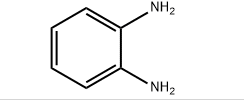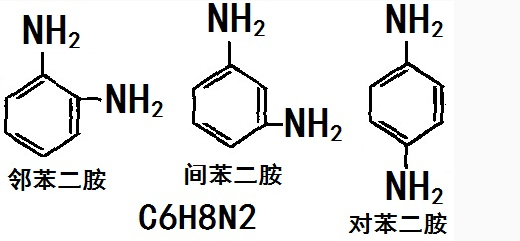Synonyms: 1,2-Diaminobenzene,1,2-Phenylenediamine,o-Phenylenediamine,OPD;1,2-Diaminobenzene,1,2-Phenylenediamine,OPD;1,2-DiaChemicalbookminobenzene,o-Phenylenediamine,OPD;1,2- Fenylendiamin;benzene,1,2-diamino-;benzene-1,2-diamine;diamino-1,2benzene;EK1700
CAS Number: 95-54-5
Molecular formula: C6H8N2
Molecular weight: 108.14
EINECS number: 202-430-6
Related categories: photosensitive materials and intermediates; biochemical reagents; benzimidazole fungicides; pesticide intermediates; fungicides intermediates; aromatic hydrocarbons; pharmaceutical intermediates; organic building blocks; dyes; general reagents; other biochemical reagents; standard products and Standard materials; pesticide intermediates: fungicide intermediates: benzimidazole fungicides; pharmaceutical raw materials; organic chemicals; Palladium Catalysis catalysts; amines; enzyme substrates; pesticides; chemicals; chemical raw materials; VARIOUSAMINE; 1,2-Benzenediamine; Organics;Biochemistry;Enzyme;Substrates;Enzymesubstrates;Amines;Aromatics;InteChemicalbookrmediates&FineChemicals;Pharmaceuticals;BiochemicalsandReagents;BuildingBlocks;ChemicalSynthesis;Derivatizationagents;LuminescentCompounds/Detection;NitrogenCompounds;Organicamines; Organic Chemical Materials Organic synthesis intermediates; intermediates; standard products; pharmaceutical, pesticide and dye intermediates; amines.


Phenylene diamine: Phenylene diamine is the simplest aromatic diamine. There are 3 kinds of isomers, namely o-phenylenediamine, m-phenylenediamine, and p-phenylenediamine. P-Phenylenediamine, also known as Ursol, is a colorless crystal that quickly oxidizes to black in the air. The boiling point is 267°C. Soluble in water, ethanol and ether. Used as a raw material or intermediate for dyes, a vulcanization accelerator for rubber, a developer in the photographic industry, fur dyes and hair dyes. Those who have more contact are hair dyers, barbers and those who dye their hair frequently. It can enter the human body through the skin. Oxidized intermediates have varying degrees of sensitization and can cause eczema-like or lichenoid dermatitis. It often occurs on the face, neck and forearms and other skin folds, such as the corners of the mouth, the corners of the eyes, and the nostrils. Damaged. Inhalation of its dust can cause bronchial asthma. Symptoms of oral poisoning are similar to those of aniline poisoning. Mainly take symptomatic treatment. O-phenylenediamine is also called 1,2-diaminobenzene and 1,2-phenylenediamine. White to light yellow leaf-like crystals are precipitated from water, and prismatic crystals are precipitated from chloroform. It is easy to change color when exposed to the air, from white to yellow Chemicalbook, brown, purple, and finally black. The relative density is 1.2698. The melting point is 103~104℃. Boiling point is 256~258℃. Slightly soluble in cold water (4.15 at 35°C), easily soluble in hot water (733 at 81°C), ethanol, ether, chloroform and benzene. It reacts with inorganic acid to produce water-soluble salt; the aqueous solution reacts with carbon disulfide to produce 2-mercaptobenzimidazole; it reacts with carbon dioxide under pressure to produce benzimidazolone. This product is toxic. After inhalation, it can cause visual disturbance, contact with the skin, cause inflammation, enter the eyes, and cause inflammation. Rat oral LD501070mg/kg. M-phenylenediamine is a rhombic crystal, which is rapidly oxidized to yellow-brown in the air. The specific gravity is 1.139. The melting point is 62.8°C and the boiling point is 284°C. Soluble in water, alcohol, ketone, etc. Used in the dye chemical industry, and as a curing agent for plastics, etc. It can enter the human body from the respiratory tract, skin and gastrointestinal tract. Acute poisoning can cause methemoglobinemia, liver damage and hemolytic anemia.

The main uses and functions of phenylenediamine:
Phenylenediamine is used as a fluorescent indicator and chromatographic analysis reagent; used in the identification of copper, gold, iron, magnesium, vanadium, ammonia, hydrogen sulfide, sulfur dioxide, chromium oxide, etc., manufacturing azo dyes, fur dyeing, photographic materials, rubber , Printing and dyeing industry.
(1) Ortho-phenylenediamine is mainly used in the manufacture of pesticide fungicides (carbendazim, benomyl, thiophanate methyl, thiabendazole), reducing dyes (Vat Yellow 6GD, Vat Brilliant Orange GR), cationic dyes ( Cationic Brilliant Yellow 10GFF), polymer stabilizers (2-mercaptobenzimidazole), heterocyclic compounds (benzimidazole and quinoxaline), photosensitive materials, surfactants, antifreeze, copper corrosion inhibitors, etc. It is one of the components of hair dye formulations, and it is also one of Chemicalbook organic reagents commonly used to identify 1,2-diketones, carboxylic acids and aldehydes in analytical chemistry.
(2) M-phenylenediamine is mainly used in the manufacture of dyes, such as direct sun-fast black RN, and used as fur dyes, as well as azo and oxazine dye intermediates, for the determination of nitrite, and also used for ion exchange resins and block copolymers. Materials and photography; used as textile dyes, laboratory reagents, vulcanizing agents, corrosion inhibitors. It is also used as a curing agent for epoxy resin and a coagulant for cement. (3) P-phenylenediamine is mainly used in the manufacture of dyes. It can be used to synthesize disperse dyes, acid dyes, direct dyes, sulfur dyes, fur dyes (fur black D) of the azo dye system, and can also be used in fur dyeing and as cosmetics. Hair dye Ursi D is also used in the production of rubber anti-aging agents (“anti-aging agent DNP”, “anti-aging agent DOP”, “anti-aging agent DBP”) and developing agents.
Chemical properties: colorless monoclinic crystal, darkening in air and sunlight. Slightly soluble in cold water, more soluble in hot water, easily soluble in ethanol, ether and chloroform.
Use:
1) Used as an analytical reagent, fluorescent indicator, and also used in the synthesis of organic and dyes
2)Used as pesticide, medicine, dye intermediate
3) As pesticide intermediates, dye intermediates
4) Ortho-phenylenediamine is an intermediate of the fungicides carbendazim, thiophanate-methyl, and thiabendazole, as well as an intermediate of the insecticide quetiaphos. In addition, it is an important intermediate in the dye industry.
5) The product is an intermediate of dyes, pesticides, additives, photosensitive materials, etc. It is the dyestuff yellow brown M. Used in the manufacture of polyamide, polyurethane, bactericides carbendazim and thiophanate, reducing scarlet GG, levelling agent, antioxidant MB, and also used in the preparation of developing Chemicalbook agents, surfactants, etc.
6) Used as intermediates of chemical raw materials, pesticides and dyes
7) Verify nickel and niobium, and determine selenium by spectrophotometry. Verification of vanadium. Separate ozone from nitrogen oxides and hydrogen peroxide. Used to distinguish nitrous acid, hydrogen peroxide and ozone. Fluorescent indicator for acid-base titration (green fluorescence for pH≦3.1, fluorescence disappearance for pH≧4.4) chelating precipitation agent. reducing agent. O-Phenylenediamine is a peroxidase substrate suitable for ELISA enzyme-linked reactions. The substrate produces a soluble end product, orange-brown in color, which can be read by a spectrophotometer at 450nm. The OPD reaction can be stopped with 3NHCl or 3MH2SO4 and read at 492nm.
8) Used as an intermediate of cationic dyes, and the main raw material of pesticide carbendazim and other antifungal agents
Post time: May-07-2021





